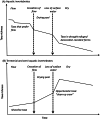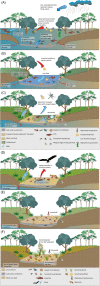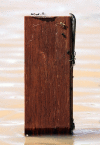The terrestrial and semi-aquatic invertebrates of intermittent rivers and ephemeral streams
- PMID: 35229438
- PMCID: PMC9542210
- DOI: 10.1111/brv.12848
The terrestrial and semi-aquatic invertebrates of intermittent rivers and ephemeral streams
Abstract
Intermittent rivers and ephemeral streams (IRES), which cease flow and/or dry at some point, are the most abundant waterways on earth, and are found on every continent. They can support a diverse, and often abundant, terrestrial and semi-aquatic invertebrate (TSAI) fauna, which has been poorly explored due to its position at the fringe between aquatic and terrestrial disciplines. TSAIs can inhabit a variety of habitat types, including the shoreline, the surface of exposed gravel bars, unsaturated gravels, dry riverbeds, riparian zones, and floodplains. Much less is known about the species composition and ecological roles of TSAIs of IRES than their aquatic counterparts, with TSAIs being largely overlooked in conceptual models, legislation, policy, and ecological monitoring. Herein we review the TSAI literature that has increased substantially over the last decade and present conceptual models describing how TSAIs respond to hydrological changes in IRES. Then, we test these models with data collected during wet and dry phases in IRES from Australia and France. These generic models can be utilised by water managers and policy makers, ensuring that both wet and dry phases are considered in the management and protection of IRES. IRES should be viewed as a habitat continuum through time, with taxa from a pool of aquatic, semi-aquatic and terrestrial invertebrates inhabiting at any hydrological stage. We call for collaboration among terrestrial and aquatic ecologists to explore these invertebrates and ecosystems further.
Keywords: Carabidae; Coleoptera; Formicidae; Hebridae; Lycosidae; Staphylinidae; exposed riverine sediments; taxonomic diversity; terrestrial arthropods; unsaturated sediments.
© 2022 The Authors. Biological Reviews published by John Wiley & Sons Ltd on behalf of Cambridge Philosophical Society.
Figures






References
-
- Abell, D. L. (1984). Benthic invertebrates of some California intermittent streams. In Vernal Pools and Intermittent Streams. Institute of Ecology Publication Number 28 (eds Jain S. and Moyle P.), pp. 46–60. University of California, Davis.
-
- Acuña, V. , Datry, T. , Marshall, J. , Barceló, D. , Dahm, C. N. , Ginebreda, A. , Mcgregor, G. , Sabater, S. , Tockner, K. & Palmer, M. A. (2014). Why should we care about temporary rivers? Science 343, 1080–1082. - PubMed
-
- Acuña, V. , Hunter, M. & Ruhí, A. (2017). Managing temporary streams and rivers as unique rather than second‐class ecosystems. Biological Conservation 211, 12–19.
-
- Adis, J. & Junk, W. J. (2002). Terrestrial invertebrates inhabiting lowland river floodplains of Central Amazonia and Central Europe: a review. Freshwater Biology 47, 711–731.
-
- Allen, D. C. , McCluney, K. E. , Elser, S. R. & Sabo, J. L. (2014). Water as a trophic currency in dryland food webs. Frontiers in Ecology and the Environment 12, 156–160.
Publication types
MeSH terms
Substances
LinkOut - more resources
Full Text Sources
Miscellaneous

